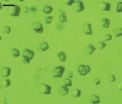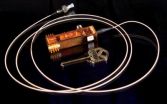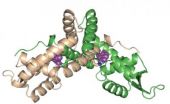(Press-News.org) The protein structure of the motor that propels archaea has been characterized for the first time by a team of scientists from the U.S. Department of Energy's Lawrence Berkeley National Laboratory (Berkeley Lab) and Germany's Max Planck Institute (MPI) for Terrestrial Microbiology.
The motility structure of this third domain of life has long been called a flagellum, a whip-like filament that, like the well-studied bacterial flagellum, rotates like a propeller. But although the archaeal structure has a similar function, it is so profoundly different in structure, genetics, and evolution that the researchers argue it deserves its own name: archaellum.
This unique motor is highly conserved in all motile archaeal species. Its structure most resembles that of the bacterial Type IV pilus, the filamentary "grappling hook" by which bacteria attach to surfaces and pull themselves along – and which is responsible for pathogenicity in many bacteria, including deadly strains of E. coli.
Since archaea may also be important players in the microbiota of the human gut, knowing the archaellum's structure will help scientists understand how archaea interact with human cells. The Berkeley Lab-MPI research team reports its findings in the journal Molecular Cell.
Finding the key protein
Sulfolobus acidocaldarius was the model organism used in the analysis, says the research team's co-leader Sonja-Verena Albers, who heads the MPI's Molecular Biology of Archaea research group, "because this is one of the few well established model systems in which genetics works well. We have the genetic tools to mutate and precisely modify the Sulfolobus genome. We can combine in vivo experiments with the atomic structure of our proteins to see the effect of modifications."
A protein called FlaI (pronounced "flah-eye") was a leading candidate for archaella assembly and rotation, but the team had to find proof. FlaI is an ATPase – an enzyme that releases energy from adenosine triphosphate, or ATP – and was known to be involved in the assembly and function of Type IV pili in bacteria and the secretion of proteins in many microorganisms. But FlaI's role in archaella was uncertain.
The Albers lab tested what happened to S. acidocaldarius when FlaI genes were deleted. Wild-type S. acidocaldarius cells have only one to three archaella on their surfaces, so "hyper-flagellated, hyper-motile" mutants with numerous archaella were created, to make deletion effects readily apparent. Deleting the FlaI gene eliminated the archaella and left the mutants unable to move. But when the researchers reintroduced the FlaI genes, the mutants were able to assemble archaella and use them to swim.
Now the challenge was to find out how FlaI performed its two functions, archaellum assembly and motility, by solving the FlaI protein structure. John Tainer of Berkeley Lab's Life Sciences Division (LSD) and the Scripps Research Institute's Department of Molecular Biology was co-leader of the research with Albers. The stable proteins of S. acidocaldarius, an extremophile able to withstand hot, acidic conditions, make it suitable for x-ray diffraction crystallography, and Tainer's postdoctoral fellow, Sophia Reindl, was able to crystallize the FlaI protein.
To do the crystallography, Reindl used beamline 8.3.1 at Berkeley Lab's Advanced Light Source (ALS), pinpointing the position of all the atoms in the FlaI protein and revealing that it consists of two parts. A globular C terminal domain, or CTD, is connected by a flexible linker to a more variable N terminal domain, or NTD, which constitutes a moveable tip.
As an energy-releasing enzyme the FlaI protein binds to an ATP nucleotide, from which it detaches a phosphate to generate energy – leaving adenosine diphosphate, ADP, in its place. After releasing the ADP, the protein binds to another ATP.
"Our goal was to solve as many structures as possible to see the protein in all its states and learn about its conformational changes," Reindl says. "If you can find different orientations between the bound states of ATP and ADP, you can assume the protein is performing a certain movement – not that you can ever get thousand-percent proof, but you know it's likely."
Reindl was able to crystallize FlaI bound to ADP, but not to ATP. Attempts to soak ATP into the crystals dissolved them, making x-ray crystallography of the ATP-bound state impossible.
"We then used SAXS at the ALS's SIBYLS beamline to look at FlaI bound to ATP in solution," she says. SAXS stands for small-angle x-ray scattering, and SIBYLS stands for Structurally Integrated Biology for Life Sciences, an ALS beamline maintained by the Life Sciences Division for which Tainer is director.
Says Reindl, "That had disadvantages – without a crystal we couldn't get atomic resolution – but in some ways the advantages were greater, because we could see the overall conformation of the protein in solution, a more normal physiological state. By combining x-ray crystallography and SAXS data we could deduce how the structure changed."
When bound to ATP, individual FlaI monomers arrange themselves into flat, six-unit rings, hexamers, with the ATPs serving as glue to hold them together. The result resembles a crown, with the CTD units forming the circlet and the free-to-move NTDs as the points.
Seven different conformations were recorded, revealing a dynamic play among the protein's components in a changing, asymmetric assembly. From the detailed images, much of the action of the archaellum motor assembly could be deduced.
How FlaI builds an archaellum
The FlaI "crown" both assembles the archaellum and causes it to rotate, but it doesn't work alone. Other important components are the protein FlaJ, which serves as a platform to which FlaI attaches and also forms a kind of bearing that penetrates the cell membrane, and FlaB, the subunits of the archaellum filament itself, plus other helper proteins.
"Just how ATPases catch the energy of ATP is a long-standing question," says Tainer. The individual monomers in the FlaI crown process the ATP and reduce it to ADP by releasing a phosphate; here the "glue" that binds a FlaI monomer to its neighbor in the crown lets go. "In this phosphate release mechanism our team – including Abrahjyoti Ghosh and Gareth Williams in Life Sciences – were able to see a state never seen before, an intermediate conformation created by the released phosophate."
Instantly the whole FlaI monomer in the crown moves upward, pushing up the FlaB filament and opening a gap at its base where waiting FlaB subunits are added to the filament, causing it to grow. The process is similar to the mechanism in a bacterial Type IV pilus, although the resulting structures operate very differently.
That FlaI is the protein uniquely responsible for both assembly and motility of the archaellum was established by further genetic studies. A mutant strain that lacked only the first 29 amino acids in the NTD point was quite capable of assembling archaella, but incapable of making them rotate.
"This mutant was interesting to us because it raised the question of how altered FlaI proteins keep the ability to assemble archaella, yet they lose their motility," says Albers. "That the N-terminal-deletion mutant can assemble archaella, but the cells are not motile, implies that after assembly a switch is thrown, and the filament starts to rotate."
The biggest challenge for the team's continuing research is to learn how, as ATP releases energy, the upward movement of FlaI monomers is transferred to the rotation of the archaellum filament. Does the hexamer – the whole FlaI crown – rotate, or only the archaellum itself? And if so, how?
"A mechanistic understanding of microbial movements is critical to assessing their impacts on planet-scale recycling of elements, climate change, and medicine," Tainer says. "We have studied Type IV pili systems for over a decade, including the ATPases needed for pathogen movement. Now this novel archaellum system allowed us to capture and genetically test a phosphate-release intermediate and other conformations that change our understanding of how the motors for all these broadly related microbial systems of movement and secretion work."
While many questions remain, the MPI-Berkeley Lab collaboration has already produced the first and only in-depth structural study on an archaellum protein, another step toward solving the mysteries of Archaea, the third domain, besides Bacteria and Eukarya, of the Tree of Life.
INFORMATION:
The research was sponsored by the National Institutes of Health (NIH), the Max Planck Institute, the Max Planck Society, and the Dutch Science Organization. The ALS is supported by DOE's Office of Science, which also supports the SIBYLS beamline in partnership with NIH.
"Insights on FlaI functions in archaeal motor assembly and motility from structures, conformations and genetics," by Sophia Reindl, Abhrajyoti Ghosh, Gareth J. Williams, Kerstin Lassak, Tomasz Neiner, Anna-Lena Henche, Sonja-Verena Albers, and John A. Tainer, appears in Molecular Cell, online at http://www.cell.com/molecular-cell/abstract/S1097-2765%2813%2900047-6.
Visit Sonja-Verena's laboratory at the Max Planck Institute for Terrestrial Biology at http://www.staff.uni-marburg.de/~albers/.
The SIBYLS beamline at the Advanced Light Source is at https://commons.lbl.gov/display/bl1231/The+SIBYLS+Beamline.
More information about how Archaea get around is at http://www.scoop.it/t/archaeal-surface-structures.
Lawrence Berkeley National Laboratory addresses the world's most urgent scientific challenges by advancing sustainable energy, protecting human health, creating new materials, and revealing the origin and fate of the universe. Founded in 1931, Berkeley Lab's scientific expertise has been recognized with 13 Nobel prizes. The University of California manages Berkeley Lab for the U.S. Department of Energy's Office of Science. For more, visit www.lbl.gov.
The Advanced Light Source is a third-generation synchrotron light source producing light in the x-ray region of the spectrum that is a billion times brighter than the sun. A DOE national user facility, the ALS attracts scientists from around the world and supports its users in doing outstanding science in a safe environment. For more information visit www-als.lbl.gov/.
DOE's Office of Science is the single largest supporter of basic research in the physical sciences in the United States, and is working to address some of the most pressing challenges of our time. For more information, please visit the Office of Science website at science.energy.gov/.
Revealing the secrets of motility in archaea
Scientists from Berkeley Lab and the Max Planck Institute for Terrestrial Microbiology analyze a unique microbial motor
2013-02-15
ELSE PRESS RELEASES FROM THIS DATE:
APS applauds President Obama's support of R&D in SOTU
2013-02-15
WASHINGTON, D.C. – The American Physical Society (APS), the nation's largest organization of physicists, commends President Obama's exhortation in his State of the Union Speech that, "Now is the time to reach a level of research and development not seen since the height of the Space Race."
During the Space Race, the nation made huge investments in scientific research, which led to new discoveries, accelerated technological advancements and generated new innovations and businesses.
The President also noted that sequestration -- automatic spending cuts scheduled to occur ...
A dual look at photosystem II using the world's most powerful X-ray laser
2013-02-15
From providing living cells with energy, to nitrogen fixation, to the splitting of water molecules, the catalytic activities of metalloenzymes – proteins that contain a metal ion – are vital to life on Earth. A better understanding of the chemistry behind these catalytic activities could pave the way for exciting new technologies, most prominently artificial photosynthesis systems that would provide clean, green and renewable energy. Now, researchers with the U.S. Department of Energy (DOE)'s Lawrence Berkeley National Laboratory (Berkeley Lab) and the SLAC National Accelerator ...
Noncoding RNAs offer huge therapeutic and diagnostic potential
2013-02-15
New Rochelle, NY, February 14, 2013—As scientists continue to unravel the complexity of the human genome and to uncover vital elements that play a role in both normal physiology and disease, one particular class of elements called noncoding RNAs is gaining a lot of attention. Guest Editor Tom Cech, PhD and Executive Editor Fintan Steele, PhD explore the enormous potential value of this rapidly advancing research area in their Editorial " The (Noncoding) RNA World." The authors introduce a special research section on noncoding RNAs published in the current issue of Nucleic ...
Building healthy bones takes guts
2013-02-15
EAST LANSING, Mich. — In what could be an early step toward new treatments for people with osteoporosis, scientists at Michigan State University report that a natural probiotic supplement can help male mice produce healthier bones.
Interestingly, the same can't be said for female mice, the researchers report in the Journal of Cellular Physiology.
"We know that inflammation in the gut can cause bone loss, though it's unclear exactly why," said lead author Laura McCabe, a professor in MSU's departments of Physiology and Radiology. "The neat thing we found is that a probiotic ...
New methodology to predict pandemics
2013-02-15
NEW YORK – February 13, 2013 – EcoHealth Alliance, the nonprofit organization that focuses on local conservation and global health issues, announced new research focused on the rapid identification of disease outbreaks in the peer reviewed publication, Journal of the Royal Society Interface. The article, authored by leading scientists in the fields of emerging disease ecology, biomathematics, computational biology and bioinformatics, shows how network theory can be used to identify outbreaks of unidentified diseases. The strategy builds on the wealth of online surveillance ...
Quantum cryptography put to work for electric grid security
2013-02-15
LOS ALAMOS, N.M., Feb. 14, 2013—A Los Alamos National Laboratory quantum cryptography (QC) team has successfully completed the first-ever demonstration of securing control data for electric grids using quantum cryptography.
The demonstration was performed in the electric grid test bed that is part of the Trustworthy Cyber Infrastructure for the Power Grid (TCIPG) project at the University of Illinois Urbana-Champaign (UIUC) that was set up under the Department of Energy's Cyber Security for Energy Delivery Systems program in the Office of Electricity Delivery and Energy ...
A microbial biorefinery provides new insight into how bacteria regulate genes
2013-02-15
PROVIDENCE, R.I. [Brown University] — Microorganisms that can break down plant biomass into the precursors of biodiesel or other commodity chemicals might one day be used to produce alternatives to petroleum. But the potential of this "biorefinery" technology is limited by the fact that most microorganisms cannot break down lignin, a highly stable polymer that makes up as much as a third of plant biomass.
Streptomyces bacteria are among few microorganisms known to degrade and consume lignin. Now a group of researchers at Brown University has unlocked the genetic and molecular ...
NASA's Fermi proves supernova remnants produce cosmic rays
2013-02-15
A new study using observations from NASA's Fermi Gamma-ray Space Telescope reveals the first clear-cut evidence the expanding debris of exploded stars produces some of the fastest-moving matter in the universe. This discovery is a major step toward understanding the origin of cosmic rays, one of Fermi's primary mission goals.
"Scientists have been trying to find the sources of high-energy cosmic rays since their discovery a century ago," said Elizabeth Hays, a member of the research team and Fermi deputy project scientist at NASA's Goddard Space Flight Center in Greenbelt, ...
Researchers discover breakthrough in ovarian cancer
2013-02-15
(Phoenix, AZ Feb. 14, 2014) -- Researchers at The University of Arizona Cancer Center at St. Joseph's Hospital and Medical Center in Phoenix have discovered that many women with low-grade serous carcinoma of the ovary or peritoneum have seen their tumors stabilize or shrink after taking a regular dose of the compound selumetinib.
The findings, published in the Feb. 14 edition of The Lancet Oncology, show that selumetinib targets a mutation in the MAPK pathway for patients with low-grade serous carcinoma, allowing for treatment on previously chemoresistant tumors.
"This ...
NASA satellite sees Cyclone Gino's rainfall shoved southward
2013-02-15
NASA's Tropical Rainfall Measuring Mission satellite known as TRMM measured Cyclone Gino's rainfall from space and saw the bulk of precipitation was south of the center. Gino's rainfall is being pushed away from the center by vertical wind shear.
TRMM flew over Cyclone Gino on Thursday, Feb. 14 at 0806 UTC (3:06 a.m. EST) and measured the rainfall rates occurring throughout the storm. The bulk of the rainfall stretched from south to southeast of the center. The heaviest rain was falling at a rate of 2 inches (50 mm) per hour southeast of the center, and scattered throughout ...
LAST 30 PRESS RELEASES:
Dramatic rise in young people using mental health services
Be careful trusting TikTok for gout advice
A study by the University of Seville links the vanishing of the specific heats at absolute zero with the principle of entropy increase
Anxiety and insomnia may lower natural killer cell count, potentially repressing immune function
How parasitic, asexual plants evolve and live
Research spotlight: A subset of patients with depression could benefit from anti-inflammatory treatment
New fully digital design paves the way for scalable probabilistic computing
Membrane electrode assembly design for high-efficiency anion exchange membrane water electrolysis
U.S. debt ceiling disputes show measurable impact on global crude oil markets
Climate extremes triggered rare coral disease and mass mortality on the Great Barrier Reef
Direct observation reveals “two-in-one” roles of plasma turbulence
Humans rank between meerkats and beavers in monogamy ‘league table’
US fossil reveals early mass-burial event and ancient microbial attack
Sedative choice could improve outcomes for breathing tube patients
New superconducting thin film for quantum computer chips
Simulations reveal protein "dynamin" constricts cell membranes by loosening its grip
Nearly 1 in 5 UK emergency department patients cared for in corridors/waiting rooms
Heavy energy drink intake may pose serious stroke risk, doctors warn
Violence against women and children among top health threats: New global study reveals disease burden far larger than previously estimated
Predicting who is at risk of developing type 1 diabetes, as new drugs now available
New gene-mapping method unlocks hidden drivers of cancer
Ocean current and seabed shape influence warm water circulation under ice shelves
Call to increase funding for ‘invisible’ Deaf victim-survivors of domestic abuse
University of Maryland School of Medicine names distinguished scientist and academic leader Gerald M. Wilson, PhD, as Chair of the Department of Biochemistry and Molecular Biology
Receptors in mammary glands make livestock and humans inviting hosts for avian flu
Icy hot plasmas
Treating adults with autism: Maryland Clinical Center offers national blueprint for care after pediatric transition
University of Phoenix College of Doctoral Studies releases white paper on reclaiming control to build workforce resilience
NCCN Summit seeks to improve care for veterans and first responders with cancer from line-of-duty exposure
ERC Consolidator Grant for soft robotics researcher
[Press-News.org] Revealing the secrets of motility in archaeaScientists from Berkeley Lab and the Max Planck Institute for Terrestrial Microbiology analyze a unique microbial motor






